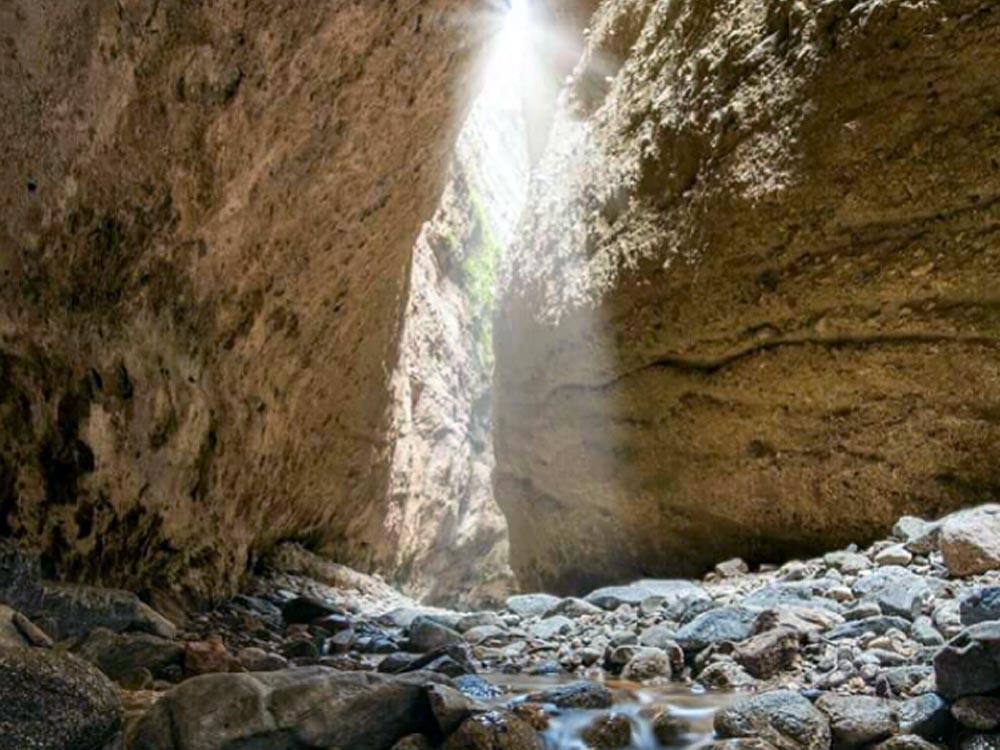Geologic monument
In the territory of the Reserve and around the neighboring mountain centers, wonderful and incomparable geological monuments rises, such as Valli Cupe Canyon, the ones of Barbaro, Timpe Rosse, Inferno, Rupa, Raga, Melissaro and Razzone along with the Gorges of Crocchio which all together represent real naturalistic gems.
Likewise, the impressive and numerous monoliths stand out among the wild slopes of the forest of Calabria – the forest of the Mediterranean par excellence – and form a small, unknown universe with an irresistible charm.
Valli Cupe Canyon, unique in Italy for its geomorphological features, has inaccessible and rugged walls cut vertically with a profile often full of a myriad of small ravines dug by atmospheric agents. Moreover, it holds the exclusive kingdom of birds that nest here in large numbers. While from a geological point of view and in reference to the European area, it is to be considered a rather rare formation because it consists of an excavation in polygenic conglomerate in sandstone matrix.
The area of Valli Cupe Canyon is rich in plant species of rare beauty, such as the bulbiferous fern (Woodwardia radicans), a typical relic of sub-tropical flora dating back to the Tertiary or Cenozoic Era, now present only in very few environments of southern Italy. The diversity of fauna is equally rich and includes numerous birds of prey (kestrel, buzzard, kite), the raven, the owl (the common one and the royal one), as well as rare and very beautiful species such as the spectacled salamander. In the same way, it needs also to be underlined the presence of Italian frog and freshwater crab.
In some areas, only a few meters wide and more than a hundred deep, Valli Cupe Canyon is a marvel of nature and one of the most evocative sites of the entire Reserve since it appears as a natural corridor where with a faint glow so that it arouses intense emotions in visitors.
The deep sandstone gorges of Razzone and Barbaro are geological formations often consisting of polygenic conglomerate resting on the underlying granite massif, as in the near Valli Cupe Canyon. They are characterized by deep and narrow ravines (whose height in some cases can reach 100 or more meters, with a baseline width of only 3-4 meters) in addition to vertiginous vertically cut walls, where the kestrels, the ravens and other birds of prey find the ideal nesting conditions.
The myrtle and the viburnum occur near the Gorges of Barbaro, in addition to acanthus, numerous pteridophytes and the rare oriental platanus, species of remarkable botanical interest.
The inside part of the Gorges is a real treasure chest of biodiversity. In particular, they represent a suitable habitat for spectacled salamander (very rare amphibian) and for the Italic frog (endemism of southern Italy), species that act as excellent biological indicators since their presence shows clean and uncontaminated environments.
The Monolith of Petra Aggìallu (Stone of the Bird) is an impressive monolith, about 18 meters high, whose shape resembles the profile of a bird head.
As it often happens for everything relating with human imagination, a rich oral memory is linked to this natural monument. It is said, in fact, that under the imposing rock a rich treasure is guarded inside a terracotta pot – locally called “a pignata”. Another recurring popular story already widespread on a large scale so as to take on mythological value – is the one according to which around the monolith it can happen to meet a hen with a brood of gold chicks.
From a geological point of view, the monolith is constituted by overlapping pieces of granite, probably deriving from a single huge block which then crashed in several points as a consequence of the thrusts caused by the movements of the crust of the Earth which are particularly frequent in Calabria.
About 18 meters high, the Monolith of Misorbo is composed by two different overlapping units of granite which are split from a cleft dating back to a remote era.
If it is observed from below, the wider unit brings to mind a human profile facing the Campanaro torrent valley, while the overlying block appears to be shaped and flat on the top. From the east side, the small shelf is protected by a wall and inside the rock there are traces resembling steps. This leads to think that a possible human intervention was made in past times although any concrete element can prove it until now. It is quite plausible, instead, that in recent times, on the east side of two meters higher above ground level, the cramped cave dug into the monolith body would have provided shelter to shepherds and woodsmen.




